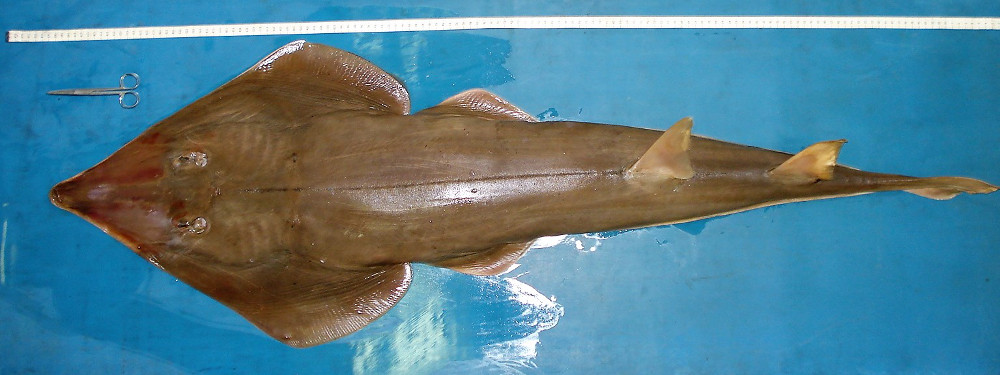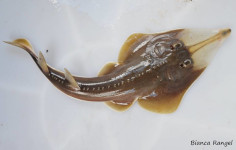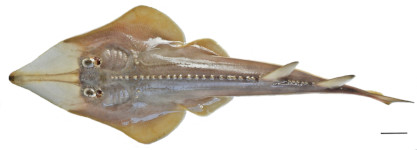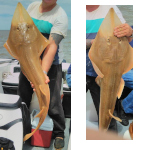Pseudobatos horkelii
(Müller & Henle, 1841)
Brazilian guitarfish
Classification: Elasmobranchii Rhinopristiformes Rhinobatidae
Reference of the original description
Systematische Beschreibung der Plagiostomen. Berlin, Veit, pp. 1–200
Systematische Beschreibung der Plagiostomen. Berlin, Veit, pp. 1–200
Image of the original description
.jpg)
Rhinobatos horkelii (Müller & Henle, 1838) valid as Pseudobatos horkelii (Müller & Henle, 1838)
.jpg)
Rhinobatos horkelii (Müller & Henle, 1838) valid as Pseudobatos horkelii (Müller & Henle, 1838)
Synonyms / new combinations and misspellings
Rhinobatos horkeli, Rhinobatos horkelii, Rhinobatos horkelli, Rhinobatus horkeli, Rhinobatus horkelii, Rhinobatus (Rhinobatus) horkelii
Rhinobatos horkeli, Rhinobatos horkelii, Rhinobatos horkelli, Rhinobatus horkeli, Rhinobatus horkelii, Rhinobatus (Rhinobatus) horkelii
Description :
Citation: Pseudobatos horkelii (Müller & Henle, 1841): In: Database of modern sharks, rays and chimaeras, www.shark-references.com, World Wide Web electronic publication, Version 01/2026
Please send your images of "Pseudobatos horkelii" to info@shark-references.com

Pseudobatos horkelii (Müller & Henle, 1838), female, 138 cm TL © Mariana Martins, Universidade Estadual Paulista, São Vicente, Brazil

Pseudobatos horkelii (Müller & Henle, 1838), female, 138 cm TL © Mariana Martins, Universidade Estadual Paulista, São Vicente, Brazil
Common names
 Geigenrochen,
Geigenrochen,  Guitarra,
Guitarra,  Brazilian guitarfish,
Brazilian guitarfish,  Cação-viola,
Cação-viola,  Raia-viola,
Raia-viola,  Viola
Viola
 Geigenrochen,
Geigenrochen,  Guitarra,
Guitarra,  Brazilian guitarfish,
Brazilian guitarfish,  Cação-viola,
Cação-viola,  Raia-viola,
Raia-viola,  Viola
Viola
Short Description
Nostrils are longer, crown is flat transversely or even slightly convex, tubercles in median row are larger, thorn like, numerous. Origin of first dorsal is posterior to the tips of pelvic fins, equal to the base of first dorsal. Upper surface uniform olive gray or chocolate brown, without pale or dark markings. Snout with an oval sooty patch [199].
Nostrils are longer, crown is flat transversely or even slightly convex, tubercles in median row are larger, thorn like, numerous. Origin of first dorsal is posterior to the tips of pelvic fins, equal to the base of first dorsal. Upper surface uniform olive gray or chocolate brown, without pale or dark markings. Snout with an oval sooty patch [199].
Human uses
fisheries: commercial
fisheries: commercial
Biology
Exhibit ovoviparity (aplacental viviparity), with embryos feeding initially on yolk, then receiving additional nourishment from the mother by indirect absorption of uterine fluid enriched with mucus, fat or protein through specialised structures [733]. Found from the coast line to the continental edge. Feeds on crustaceans, cephalopods, polychaetes and small fishes.
Exhibit ovoviparity (aplacental viviparity), with embryos feeding initially on yolk, then receiving additional nourishment from the mother by indirect absorption of uterine fluid enriched with mucus, fat or protein through specialised structures [733]. Found from the coast line to the continental edge. Feeds on crustaceans, cephalopods, polychaetes and small fishes.
Size / Weight / Age
138 cm TL (male/unsexed; [19579]); Total length–disc width relationships were DW = 2.36 + 0.32TL (r2 = .953; n = 70) and DW = 27.27 + 0.27TL (r2 = .991; n = 71) for males and females (database: 71 males and 72 females), size at maturity was 70.2 cm TL for males [26017]
138 cm TL (male/unsexed; [19579]); Total length–disc width relationships were DW = 2.36 + 0.32TL (r2 = .953; n = 70) and DW = 27.27 + 0.27TL (r2 = .991; n = 71) for males and females (database: 71 males and 72 females), size at maturity was 70.2 cm TL for males [26017]
Remarks
shark-references Species-ID=14580;
shark-references Species-ID=14580;
Parasites (arranged by Jürgen Pollerspöck)
Myxosporea
Cestoda
Myxosporea
- Chloromyxum sp. [28169]
Cestoda
- Acanthobothrium goleketen Irigoitia, Franzese & Alarcos, 2025 [34924]
- Caulobothrium pieroi Menoret & Ivanov, 2023 [32533]
- Rhinebothrium quequense Menoret & Ivanov, 2023 [32533]




















